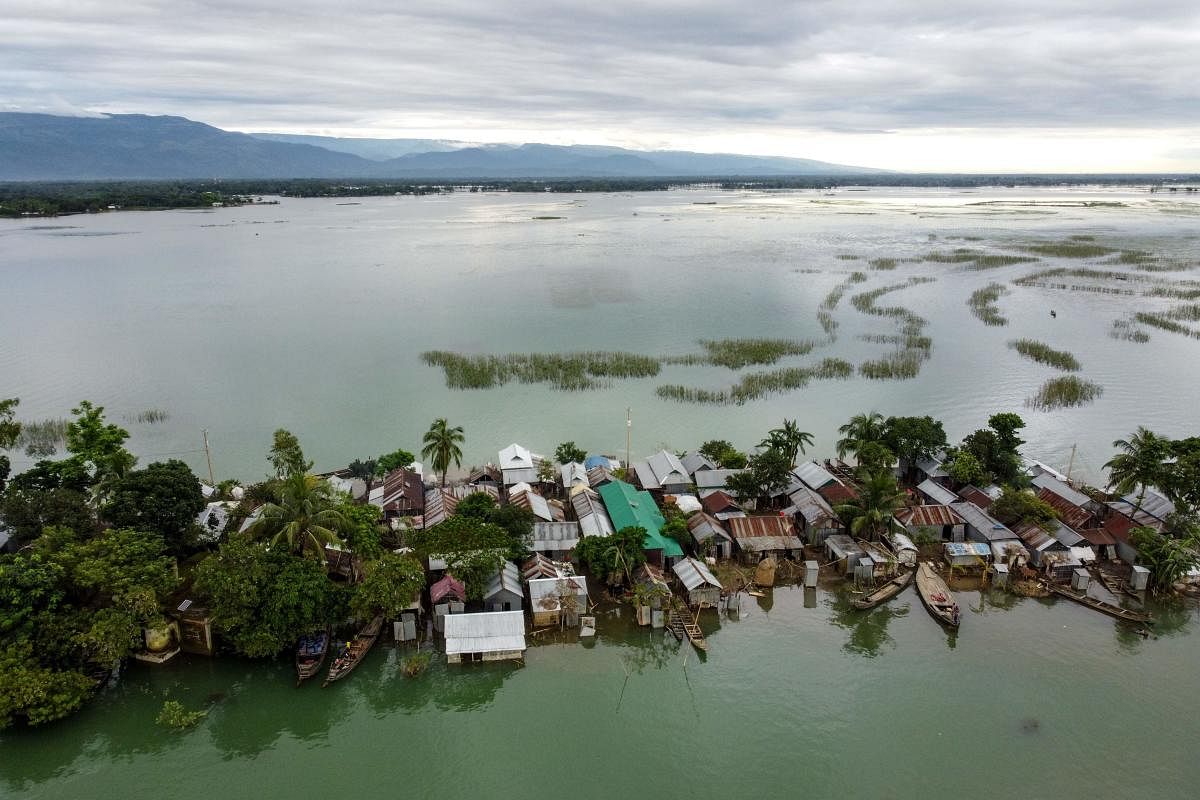
When heavy floods started inundating her riverside home last week in the village of Madarganj, northern Bangladesh, Habiba Begum chose to stay put with her family instead of moving to shelter.
Begum’s family, desperate to save what few possessions they had, chained their only suitcase to their house, a makeshift structure of bamboo and banana leaves constructed after the last devastating flood in the area, just two years ago.
As the waters rose, the house was marooned in muddied waters, and the family had to cook meals on a raised area of dry ground nearby.
Then tragedy struck. Begum left her 1-year-old daughter, Lamia Khatun, on a patch of higher ground while she washed clothes in floodwaters on Tuesday. But the waters kept rising.
“When I came back, she was gone,” Begum, 32, said. “We found her body hours later.”
Across southern Asia, more than 4 million people have been hit hard by monsoon floods that have destroyed homes and structures, drowned entire villages and forced people to crouch on rooftops hoping for rescue.
The monsoon season — usually June to September — brings a torrent of heavy rain, a deluge that is crucial to South Asia’s agrarian economy.
But in recent years, the monsoon season has increasingly brought cyclones and devastating floods, causing the internal displacement of millions of people in low-lying areas, particularly in Bangladesh.
Last year, at least 600 people were killed and more than 25 million affected by flooding because of the torrential monsoon rains in Bangladesh, India, Myanmar and Nepal, according to the United Nations. And in 2017, more than 1,000 people died in floods across South Asia.
Rainfall has been heaviest this year in northeast India, Bangladesh, Bhutan, Myanmar and Nepal, according to the Southeast Asia Flash Flood Forecast System, which is affiliated with the United Nations.
Bangladeshi authorities say that the flooding started in late June, inundations are expected to continue this month, and more areas will be affected.
Enamur Rahman, the Bangladeshi minister for disaster management, said the inundations were the worst in decades and that hundreds of thousands of families had been marooned, forcing the authorities to open more than 1,000 emergency shelters.
“We are fighting the catastrophe with every possible resource available,” Rahman said. “It seems rains and floods will be prolonged this year.”
Researchers have warned that within a few decades, Bangladesh, with a population of more than 160 million people, may lose more than 10% of its land to sea-level rise, caused by a warming climate, displacing as many as 18 million.
India has also suffered immensely. Floods have swept across the states of Assam, Bihar, Odisha, West Bengal and other areas in the eastern part of the country. Authorities have said that at least 85 people have died, with more than 3 million affected by the deluge.
In the northeastern state of Assam, Kaziranga National Park, a World Heritage site that is a home to the one-horned Indian rhinoceros, a species listed as vulnerable by the WWF, has been completely inundated. Officials said that more than 50 animals had died in the flooding, though some wildlife had been rescued.
With more than a dozen rivers and tributaries swelling above the danger mark, rescue operations have been carried out in at least 22 districts across Assam.
In Nepal, 67 people have died and 40 others are missing, according to the National Emergency Operation Center.
That is in additional to the monsoons that have battered Bangladesh. Low-lying and densely populated, with 165 million people, the country is chronically ravaged by flooding.
In Jamalpur, in the north, the flood situation has become critical, with rivers flowing well above the danger level. Muneeb-ul-Islam, 42, who lives in the area with his wife and three children, said he had lost his home several times in 10 years, leaving him with nothing but the clothes he was wearing.
Muneeb-ul-Islam and his family are among more than 1 million people in Bangladesh left displaced or homeless by the floods.
“It is as if we have committed some sin,” he said. “This is the third time in the last few years that we will have to rebuild our lives from scratch.”
Begum, who lost her 1-year-old, said her life had been completely destroyed. She has now moved to a nearby shelter, a school building, where hundreds of people were crammed in. Fear of the coronavirus spreading in such cramped quarters looms large. Begum’s family said there had not been enough warning about the magnitude of the flooding.
“I will never go back to the place where we used to live,” she said, “The water has snatched everything from us.”